31 TOP LANDMARKS IN EGYPT – FAMOUS MONUMENTS & ATTRACTIONS
A complete rundown of the absolute must-see landmarks in Egypt, from ancient monuments to world-famous attractions.
Egypt is a travel destination that inspires awe and wonderment in us all. Whether you’re a passionate history buff or simply intrigued by marvels like the Egyptian Pyramids, then trust me when I say that Egypt is guaranteed to leave you speechless!
In this guide, I’ll give you a run-down of the most famous landmarks, tourist attractions, monuments, and historical sites of Egypt so you can discover the best places to visit when exploring this amazing transcontinental country between North Africa, the Middle East, and Asia.
Top Egypt Landmarks
Did you know that in Egypt, a new discovery is made every single month?
Whether it’s forgotten ancient temples, new burial sites, or even entire cities lost beneath the sands, uncovering the historical landmarks of the Ancient Egyptians is a perpetual process that puts us closer to understanding the lost knowledge of one of the world’s greatest civilizations.
I’ve broken up this guide into four sections, including landmarks and important points of interest in Cairo, Aswan, Luxor, and other parts of Egypt stretching from the Mediterranean Sea to the Sinai Peninsula.
Below is a useful map with all of the highlights pinned.
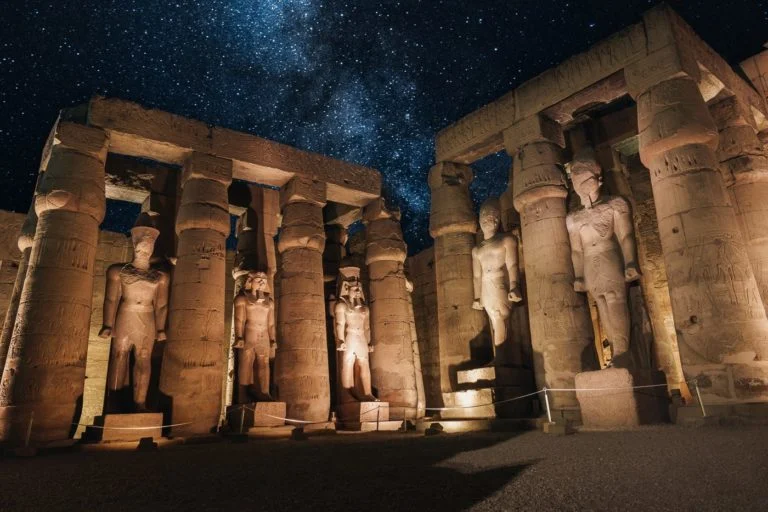
Egyptian Landmarks & Ancient Sites Near Cairo
While Cairo is the current capital of Egypt and the second-largest city in the Arab World, it did not exist in the times of the Ancient Egyptians.
However, being located on the River Nile, just 15 miles north of the ancient capital Memphis and neighboring the Giza Plateau, travelers can expect to find some of the most famous landmarks from the Old Kingdom here; including the Pyramids of Giza, the Sphinx, and the Saqqara Necropolis.
Must-see landmarks near Cairo include
- Great Pyramid of Giza
- Pyramid of Khaphre
- Pyramid of Menkaure
- Great Sphinx of Giza
- Step Pyramid of Djoser
- Saqqara Necropolis
- Hanging Church
- Khan El-Khalili Bazaar
- Muhammad Ali Mosque
- The Egyptian Museum
1. Great Pyramid Of Giza
The Great Pyramid of Giza is the oldest of the Seven Wonders of the Ancient World, and the only one still intact. Not only is this Great Pyramid the most famous monument in Egypt, but it’s also by far the most remarkable ancient structure in the world.
This 138-meter (452-foot) monolith is the largest pyramid on the Giza Plateau and covers an area of over 13 acres.
While it is believed to have been built between 2550 to 2490 B.C in the time of the Fourth Dynasty pharaoh Khufu, it held the title of the tallest man-made structure on earth until the construction of the Eiffel Tower in 1887.
The Ancient Egyptians built the Great Pyramid using 2.3 million stone blocks, estimated to weigh over 2000 pounds each (1 tonne). However, some of the larger blocks, specifically the immense cantilevered granite slabs suspended above the King’s Chamber weigh between 65 – 70 tonnes each!
These blocks are laser-precision cut to perfect 90-degree angles and were transported all the way from Aswan (over 800 km or 500 miles away).

Also, as a reflection of the night sky, the Great Pyramid, along with the other Great Pyramids of Giza, Menkaure, and Khafre, is a perfect mirror of the belt of three stars we now call the Orion’s Belt.
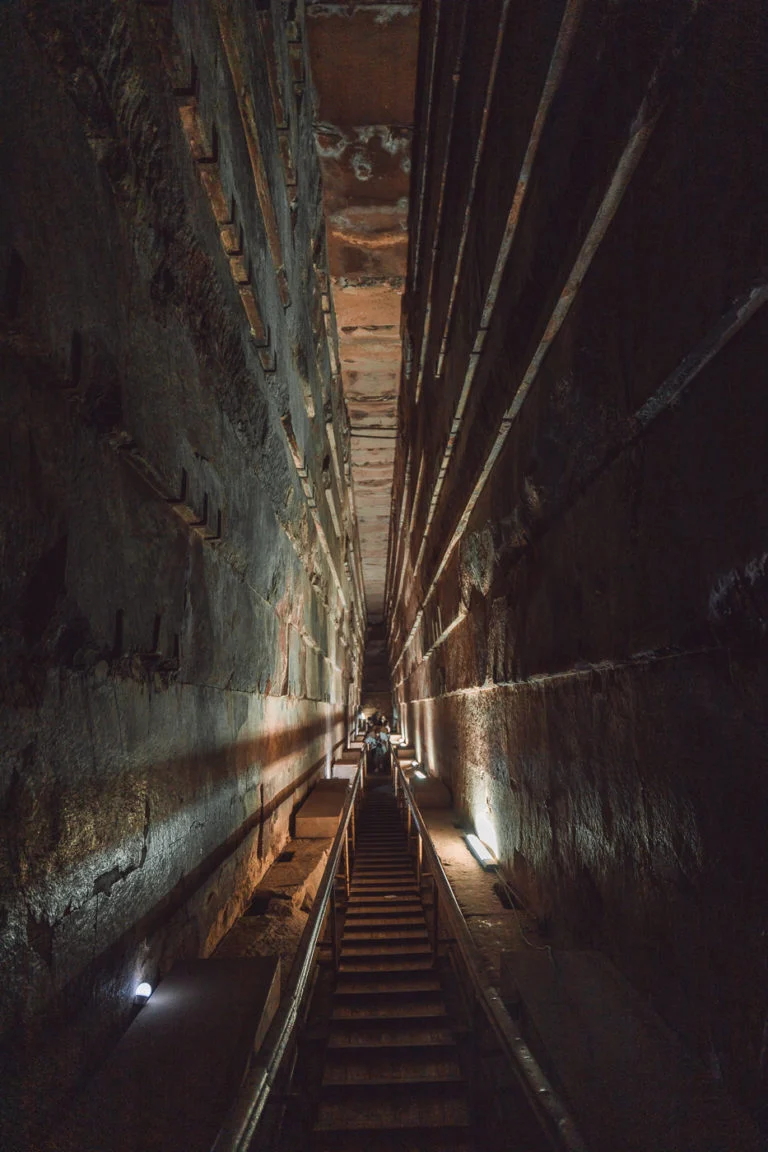
Travelers looking to visit the greatest of all Ancient Egyptian landmarks can do so by heading to the Giza Pyramid Complex, just outside of Cairo. This requires an entry fee, along with an additional fee to enter the Great Pyramid (definitely worth it).
Best-value one-day trip from Cairo: Pyramids of Giza, Sphinx, Saqqara, & Memphis Full-Day Trip
2. Pyramid Of Khaphre
Of course, I can’t compile a list of the famous landmarks in Egypt without mentioning the other two Great Pyramids of Giza.
The first, and most identifiable of the three is the Pyramid of Khaphre (or Chephren). This is the second-tallest pyramid, standing at a height of 136 meters (448 feet).
However, this pyramid is built on a 10-meter-tall base of bedrock. As a result, Khaphre’s Pyramid initially appears taller than the Great Pyramid.
Furthermore, unlike the other monuments of the plateau, the Khaphre Pyramid still has remnants of its cladding on its pyramidion (the capstone), which in ancient times was coated in gold.
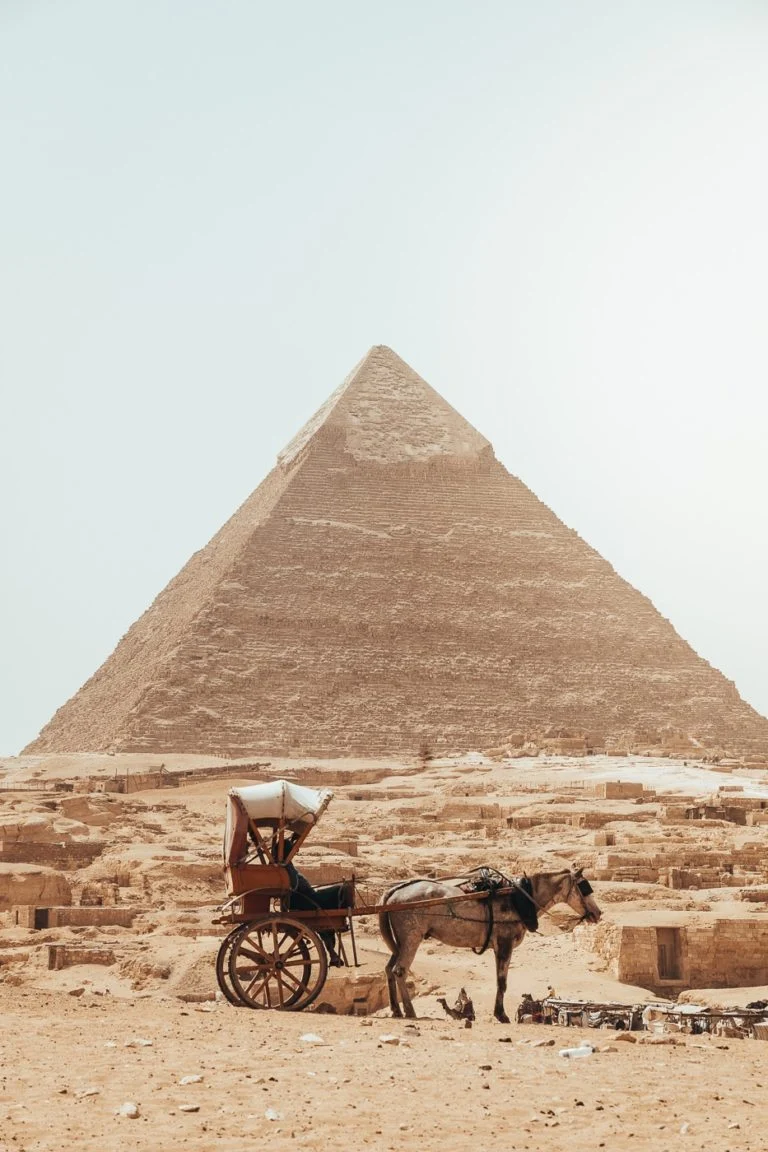
3. Pyramid Of Menkaure
The third and smallest Ancient Egyptian landmark within the Giza Pyramid Complex is the 65-meter (213 feet) Pyramid of Menkaure.
While dwarfed by its larger neighbors and consequently often overlooked by most visitors, Menkaure’s pyramid is still a worthy addition to this list of must-see attractions in Egypt.
While you can’t go inside this pyramid, you should take time to check out the complex’s other three smaller pyramids. These were believed to be dedicated to the queens of the ancient Pharaohs and have been named the Queen’s Pyramids as a result.
Out of the three, only the largest was fully completed and housed a statue of an ancient queen.
4. Great Sphinx Of Giza
As far as famous landmarks in Egypt go, none are as iconic as the Great Sphinx of Giza. Visitors will find this amazing attraction directly adjacent to the Great Pyramids.
This huge limestone statue is the largest surviving statue from the ancient world. It is carved from one single piece of limestone exposed within a man-dug quarry and depicts a recumbent sphinx with the body of a lion and a head of a pharaoh.
The easy way to carve out the sphinx would be to slowly chip it out of the limestone, piece by piece. Instead, the ancient architects cut out huge rectangular slabs and used them to build the “Sphinx Temple”, right beside the monolith.
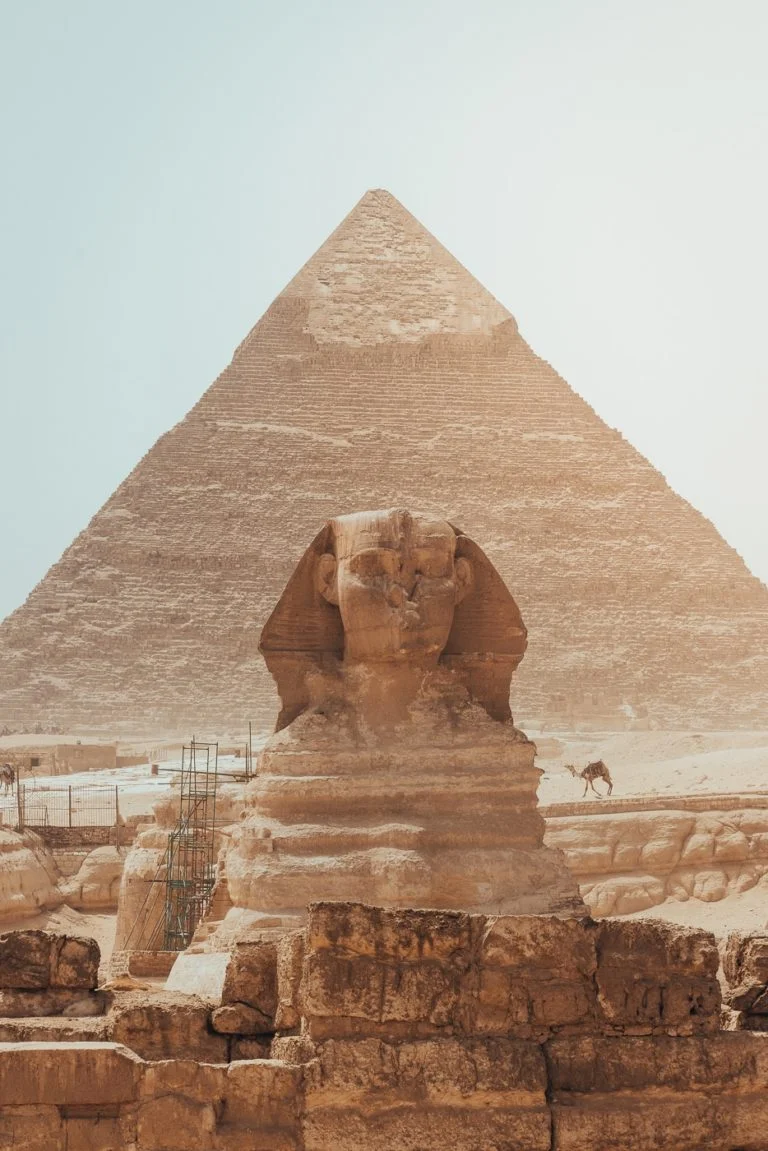
The Great Sphinx is one of the most fascinating and mystifying historical landmarks in Egypt. Traditional Egyptologists tend to date it at around 4,500 years old. However, the truth is that nobody knows exactly when it was built, who it was built by, or what it was built for.
One fascinating school of thought dates the Great Sphinx to at least 5,000 BCE, or 7,000 years old (or potentially much older).
This is due to the water erosion on its core body and on the walls of the quarry first discovered by geologist Robert Schoch. This revised dating proposal stems from the fact that this part of the Sahara desert has not experienced enough rainfall to cause this type of erosion for at least 7,000 years.
This dating would place the Great Sphinx of Giza as the oldest surviving landmark from Ancient Egypt. Of course, this far-reaching timeline was initially met with strong hesitance but has become more and more feasible since the discovery of Göbekli Tepe, an ancient temple complex in nearby Turkey built over 11,000 years ago.
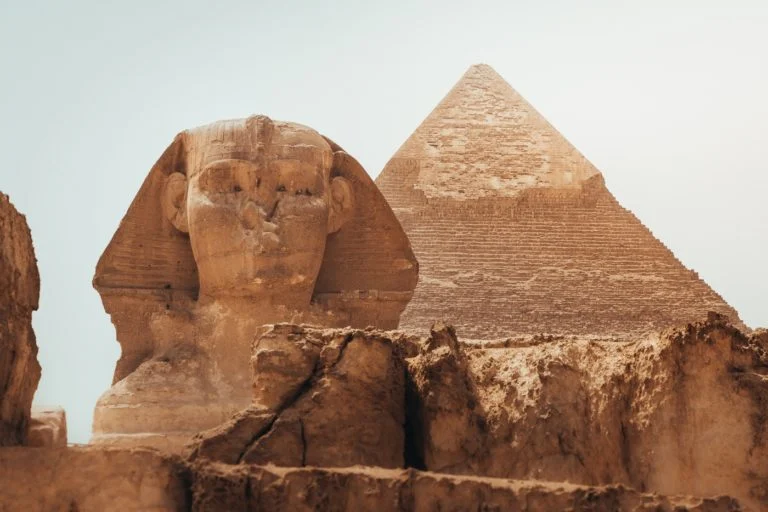
5. Step Pyramid Of Djoser
Move 12 miles (20 kilometers) south from the Giza Plateau along the West Bank of the Nile and you’ll discover the Step Pyramid of Djoser.
Located within the Saqqara Necropolis and featuring six steps and a series of subterranean labyrinth tunnels, the Djoser Pyramid is a popular place to visit to get a glimpse of the very first pyramid ever built.
This Egyptian Monument is believed to be the oldest of its kind with an agreed dating of somewhere between 2667 and 2648 BCE. This was during the reign of Third Dynasty Pharaoh Djoser, who commissioned the famous architect and high priest Imhotep to invent the design.
6. Saqqara Necropolis
The Step Pyramid of Djoser isn’t the only famous Egyptian landmark on this sandy patch on the outskirts of Cairo. In fact, the Step Pyramid is just one of many notable tombs, pyramids, temples, and stone monuments within the ancient Saqqara Necropolis.
Saqqara served as the necropolis for the ancient capital Memphis for more than 3,000 years, with another 16 pharaohs building pyramids here.
Additionally, there are hundreds of underground tombs here, many still waiting to be discovered. Just a few weeks before I visited, archaeologists unearthed five brand new and perfectly preserved underground tombs.
As you might expect, touring this huge area will take a while. To save time, I recommend checking out the following attractions.
- Step Pyramid of Djoser
- Pyramid of Teti
- Pyramid of Unas
- Tomb of Nefer-her-ptah
- The Serapeum (burial chamber of the Apis bulls)
- Tomb of Mereruka
7. Hanging Church In Coptic Cairo
Considering Egypt has at least 5000 years of history, you can expect to find famous landmarks and other historical places from a wide range of cultures and religions.
For visitors to Cairo, a region to explore is Old Cairo. This is a historic area housing several Roman and Islamic-era landmarks.
One significant building in Coptic Cairo (Old Cairo) is the Hanging Church or the Sant Virgin Mary’s Coptic Orthodox Church.
This is one of the oldest churches in Egypt and is built suspended over a passage on top of the gatehouse of the Babylon Fortress. Visitors are free to explore the church, which dates back to around the years 690-692
Book a tour: Cairo Citadel, Old Cairo & Khan El Khalili
8. Bazaar Khan El-Khalili
Located within the historic center of Cairo is the Khan el-Khalili, a world-famous bazaar and souq (souk), established in the Mamluk era (1250-1517).
This makes it the oldest market in the middle east and one of the most famous places of Egypt.
Today, it’s still very much a living market. Khan El-Khalili bazaar attracts thousands of tourists and Egyptians daily to wander its streets, browse wares, and eat traditional Egyptian street foods like koshari, foul, and falafel.
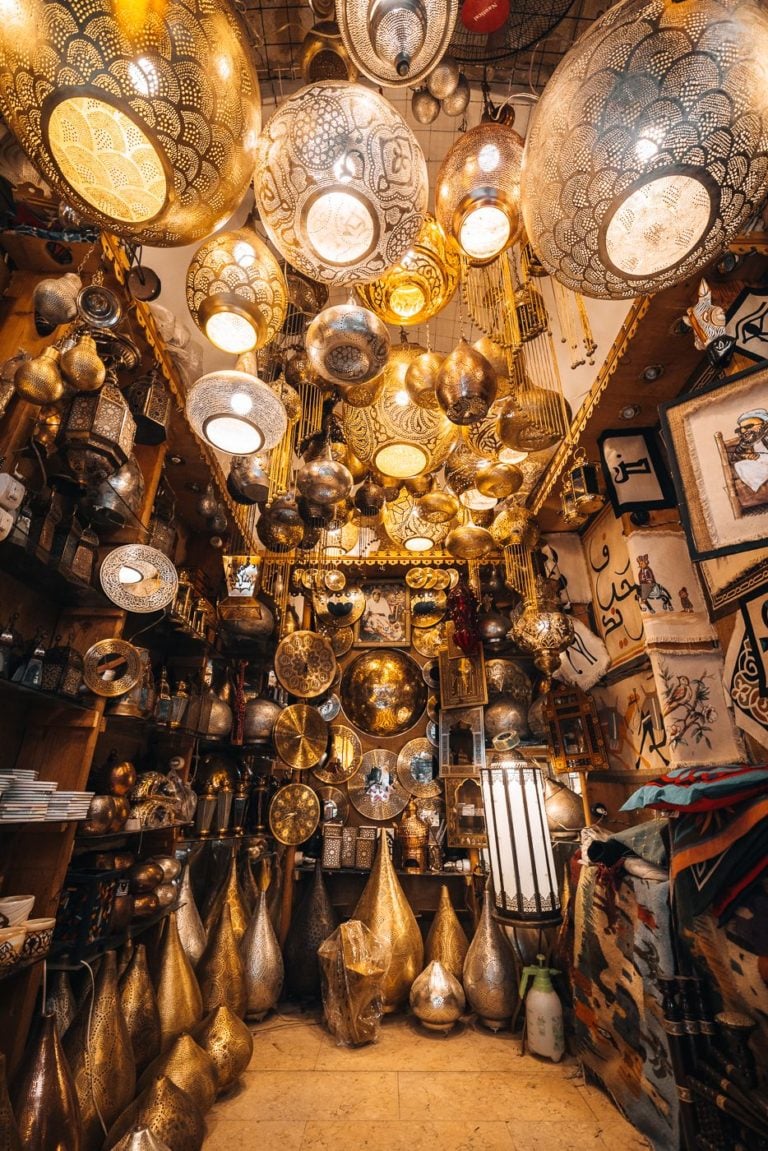
9. Muhammad Ali Mosque
Another very impressive landmark in Egypt is the Muhammad Ali Mosque located in Historic Cairo (Islamic Cairo).
This beautiful mosque was built by Mohammad Ali Pasha (not the boxer), between the years 1830 and 1848. Located on a tall hillside, this Turkish-style mosque is one of the most prominent features of Cairo’s skyline.
This is truly one of the most beautiful buildings in the modern city and one you should definitely visit when traveling in Cairo.
Fun fact: The limestone used to build the Muhammad Ali Mosque was likely taken from the original outer sheet of the Great Pyramids of Giza.
10. Egyptian Museum
The final landmark and major attraction in Cairo is the Egyptian Museum.
This is the oldest archaeological museum in the Middle East and houses some of the greatest archeological treasures in the world. The most famous attraction in the Egyptian Museum is the Tutankhamun Exhibition, which features the famous gold-cast headdress along with all of the boy king’s treasures found in his tomb.
While on the TravelTalk tour, we stopped at the Egyptian Museum at the end of the trip. This allowed us to really appreciate all of the artifacts after having learned so much about the ancient pharaohs during our travels in Egypt.
One thing you should know is that when visiting the museum, it’s really best to have a guide. That’s because many of the displays lack any information plaques.
Book a guide: Pyramids, Museum & Bazaar Private Tour
Egypt Attractions & Monuments Near Aswan
After Cairo, Aswan is the second most popular tourist city along the River Nile. While much less hectic than Cairo, Aswan is still a bustling metropolis home to over 1.5 million people.
Aswan lies within what is considered “Upper Egypt” (referring to the flow of the Nile, not the cardinal marks). Here, visitors will find many famous Egypt landmarks, making it one of the best places to visit for history lovers.
Must-see landmarks near Aswan include
- The Unfinished Obelisk
- The Temple of Philae
- The Aswan High Dam
- Abu Simbel Temples
- Nubian Villages
- The Temple of Kom Ombo
11. Unfinished Obelisk
If you thought the 70-tonne granite blocks hanging above the Great Pyramid were heavy, wait until you find out about the Unfinished Obelisk of Aswan.
This giant 1,100-tonne slab of granite lies just outside of Aswan along the Nile River. It’s one of the most popular landmarks for those interested in Egyptology since if it had been completed, it would be the largest and heaviest obelisk ever built by ancient Egyptians.
The fact that it was never completed is actually a bit of a blessing since it gives us valuable insights into how the ancients built these gigantic structures out of a single slab of rock.
12. Temple Of Philae
Another significant landmark near Aswan, Egypt is the Philae Temple, or Temple of Isis, dedicated to Isis, Osiris, and Horus.
While it still retains its name, the temple has been moved, block by block, from its original place on Philae Island to the nearby Agilika Island due to the construction of the Aswan High Dam.
The Temple of Philae is relatively new (by Ancient Egyptian standards) and was built in 280 BCE during Egypt’s Greco-Roman Period under the reign of Ptolemy II.
This is a great temple to visit since its walls are absolutely covered in ancient hieroglyphs. Many depict mythological scenes telling the story of Isis reviving Osiris and birthing Horus.
13. Aswan High Dam
Although far from an ancient Egyptian landmark, the Asan High Dam is one of the most famous modern sites in the country. Egypt completed the project in 1970, with the total cost to the country surpassing 1 billion dollars.
Today, the Aswan Dam contributes massive amounts of money to the Egyptian economy through hydroelectric power and places the historical flooding of the Nile in human hands for the first time in history.
However, the period during its proposal was a stressful one for lovers of ancient history. That’s because the project placed several historical sites under severe risk. Luckily, beginning in 1963, UNESCO’s multi-year and multi-national plan began to break down the temples and relocate them to safer ground.
Fact: There are a total of 7 UNESCO World Heritage Sites in Egypt. However, many of these designations cover various buildings and monuments spread over a large area.
14. Abu Simbel Temples
Out of all the amazing New Kingdom temples on the Nile River, Abu Simbel is one of the most remarkable. Known as the Twin Temples, these amazing temples were carved into and out of a mountain cliff.
The two temples were commissioned by the most celebrated of all Ancient Egyptian kings, Ramses II to celebrate the victory of the Qadesh battle.
Inside both temples, visitors can marvel at the amazing floor-to-ceiling hieroglyphics dedicated to the gods Amon, Ra-Horakhty, and Ptah.
However, the most impressive of the two, known as the Great Temple, is guarded by four giant colossi depicting a deified Ramses II during different stages of his life. Also, as you walk inside, you’ll enter a long Hypostyle Hall with six huge statues of Osiris and several side chambers.
Tip: Due to the long distance from Aswan, the Abu Simbel Temples are not very easy to get to independently.
15. Nubian Village
The outskirts of Aswan along the Nile River are dotted with the vibrant and cheerful villages of the Nubian people.
Nubians are the indigenous people of northern Sudan and southern Egypt. While much of their history is overshadowed by Ancient Egypt and its great Pharaohs, the truth is that Nubian history predates even the oldest Egyptian dynasties.
In fact, Nubians have lived in the central Nile Valley for over 8000 years and are recognized as being among the oldest living cultures on earth, with a history dating back to the cradle of civilization.
If you’re looking for important landmarks to visit in Egypt, don’t miss out on visiting a Nubian village. You’ll find many dotted along the west bank of the Nile and Elephantine Island.
While Nubians are very friendly people, it’s best to visit on an organized tour. Not so much for safety, but because the locations can be quite remote. We visited several villages and even shared a traditional meal in a local village on our tour with TravelTalk.
16. Temple Of Kom Ombo
Kom Ombo Temple is another great example of Egyptian temples during the Ptolemaic period. However, this one is quite unique since it is one of the only “double” or “split” temples in Ancient Egypt.
What this means is that the temples, courts, sanctuaries, and halls are duplicated to honor two sets of gods, namely the crocodile god Sobek, and the falcon god Haroeris (Horus the Elder).
However, the most interesting feature of this temple is a set of hieroglyphs depicting an Ancient Egyptian calendar.
This calendar is unique to Egypt and depicts three seasons revolving around the River Nile. The three seasons depicted include the flood, the sow, and the harvest. Each of these seasons are broken into four months, each with three 10-day weeks.
This adds up to 360 days per year but the remaining five and 1-quarter days of the solar year were added to the end of each year, which was designated as a public holiday.
Another attraction at Kom Ombo is the Crocodile Mummy Museum, where visitors can see extremely well-preserved crocodile mummies.
Famous Egyptian Monuments & Landmarks Near Luxor
Luxor is the third tourist city along the River Nile, and for many visitors, it’s the most fascinating place in Egypt since it once housed the Middle and New Kingdom capital Thebes. Luxor is also very near the famed resting place of the Great Pharaohs– the Valley of the Kings.
Must-see landmarks near Luxor include
- Luxor Temple
- Valley of the Kings
- Mortuary Temple of Hatshepsut
- Karnak Temple
- Colossi of Memnon
- Temple of Edfu
17. Luxor Temple
Many refer to Luxor Temple as the world’s largest outdoor museum. It’s located on the east bank of the Nile River, right in the heart of Luxor (what was then ancient Thebes).
This amazing temple was constructed as late as 1400 BCE in dedication to the rejuvenation of kingship and may be the site where new Pharaohs were crowned. Many also regard it as the most significant religious center in Ancient Egypt.
The Temple of Luxor is very large and in very well-preserved condition. You’ll see much of this impressive Egyptian landmark still intact, including its huge pylons, obelisks, colossi, and carvings.
We visited this monument at night, which I’d highly recommend as the light setup is extremely impressive.
18. Valley Of The Kings
After the Sphinx and the Great Pyramids of Giza, the Valley of the Kings is the most famous landmark in Egypt.
This barren valley on the west bank of the Nile is the burial ground for many ancient Pharaohs and their families. It’s an active archaeological site where you can explore intricate underground tombs, each with complex underground systems of tunnels and chambers.
Unfortunately, many of the tombs of Pharaohs were looted by grave robbers since antiquity. However, the art and hieroglyphs on the walls of the many chambers and tunnels are some of the most well-preserved in Egypt.
An entrance ticket to the Valley of the Kings includes entry into three tombs, with an additional fee to see Tutankhamun’s (where his mummy still rests).
Tip: If you have time, I highly recommend booking a Hot Air Balloon experience over the Valley of the Kings. This was by far one of the greatest highlights of my trip with TravelTalk Tours and a real once-in-a-lifetime moment.
19. Mortuary Temple Of Hatshepsut
Located close by to the Valley of the Kings is the Mortuary Temple of Queen Hatshepsut, built between 1479 and 1458 BCE.
Like several grand Egyptian monuments, Pharaoh Hatshepsut built this temple as a tribute to the gods and to tell the story of her greatest achievements.
For visitors, this amazing landmark in Egypt offers some of the best examples of colored hieroglyphs within a temple. Many of the intricate carvings on its ancient walls are still very vivid, which, seeing it first hand, demands a newfound appreciation of the art.
The most interesting hieroglyphs to me were those depicting scenes of stocked boats bringing back exotic plants, foods, treasures, and animals from far away lands. Among these are rows of chained lions and leopards, as well as stacks of African palms and Mediterranean plants.
20. Karnak Temple
The Karnak Temple is the biggest and most significant complex in all of Egypt. It’s also the largest religious building ever built, with a total of 134 giant columns, some of which are more than 21 meters (70 feet) high and 8 meters (27 feet) in circumference.
These pillars support immense architraval beams made from solid granite and weighing up to 70 tonnes each!
Let me tell you, this is one impressive landmark that you will not want to miss when visiting Egypt.
Dating back to as far as 2,000 BC, it’s estimated that over 30 Pharaohs continued construction on this site over the span of nearly 2000 years. When I say it’s huge, the complex covers an area of over 250,000 square meters (2.69 million square feet).
However, many of the buildings still standing today are from the New Kingdom period due to various changes induced by different religious ruling classes throughout the dynasties.
21. Colossi Of Memnon
Along the main road leading to the Valley of the Kings are two giant colossi statues that are definitely worth a quick stop. Known as the Colossi of Memnon, these landmarks stand at the ruins of the Mortuary Temple of Amenhotep III and are two statues representing the late pharaoh.
These giant figures are both carved out of a single block of sandstone and weigh up to 650 tonnes each!
Carved on the front of the statues are two small figures representing Pharaoh Amenhotep III’s wife Tiye and his mother Mutemwiy.
22. Temple Of Edfu
Moving back 100 kilometers south of Luxor, around halfway to Aswan, is the Temple of Edfu, or the Temple of Horus.
Similarly to other famous landmarks in Egypt like the Philae Temple and the Temple of Kom Ombo, the construction of this temple took place during the Ptolemaic Kingdom at the end of dynastic Egypt around 305 BCE.
This makes the Horus Temple Complex quite new, as far as Ancient Egyptian history goes. Regardless, it is one of the most beautiful and intricate temples in Egypt, dedicated to the falcon god Horus.
Horus is one of the most important gods in Ancient Egypt. Even today, due to countless mythological similarities, many theologists believe that Horus is the original “solar messiah”.
They believe cultures have passed his story through the ages to form new religious deities with remarkably similar traits, including Attis of Greece, Krishna of India, Mithra of Persia, and even Jesus Christ.
The temple itself is just as impressive. Egyptologists suggest that it took the ancients over 180 years to build this amazing monument, building it on top of an existing ruin.
